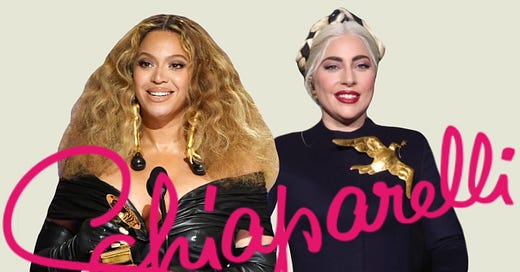When I was first playing with the idea of a newsletter, I knew Elsa Schiaparelli (pronounced “skip-relli”) deserved a dispatch of her own. I’d planned to take a “here’s the most famous couturier you’ve probably never heard of” approach. Then, Lady Gaga wore the fashion house to sing the national anthem at the Biden inauguration. Then, Beyoncé accepted her history-making 28th Grammy in the label’s custom couture. This wasn’t the first instance of either of these women wearing Schiaparelli: Gaga has incorporated both custom and seasonal collection pieces in her shows for years, and Beyoncé wore an angelic black and gold number to the 2020 Golden Globes.
The brand, formerly known by only the avid haute couture followers among us, is slowly but surely climbing into the public consciousness. But Schiaparelli is nothing new. The house dates back to 1927, and it’s founder, Elsa, was a contemporary and competitor of Coco Chanel. It’s not a household name yet, like Dior, Prada, Chanel, or St. Laurent, but I guarantee it will be in the next year. Why? The brand has been simultaneously modernized and returned to its roots by artistic director Daniel Roseberry.
In the statement announcing his appointment on the maison’s website, Roseberry is quoted saying, “Schiaparelli was a master of the modern; her work reflected the chaos and hope of the turbulent era in which she lived. Today, we find ourselves asking similarly big, identity-shaping questions of our own: What does art look like? What is identity? How do we dress for the end of the world?”
Can you think of a better fashion ethos for our current experience? The most recent collections are surrealist and anchored in representations of the body. Teeth, ears, Dali-esque eye glasses, gladiator-style chest plates, and elements that leave the garment to march across the skin define Roseberry’s tenure. The body is the art, but not in the sense of the swan necks and jutting hipbones and clavicles that've historically gatekept fashion from all bodies. Schiaparelli is deeply weird, which is what made the brand a standout from its genesis.
When Elsa was alive, the Italian iconoclast made knits, sportswear, provocative evening wear, ski suits, and beach pajamas, and was the first to use visible zippers in Haute Couture. She introduced the idea of “hard chic,” bringing powerful, architectural silhouettes for womenswear. In the ‘30s she collaborated with Salvador Dali on iconic pieces like the shoe-hat, a lobster printed dress, a skeleton dress, gloves with built-in long, red finger nails, and a necklace encrusted in insects. In 1937 she created the color “shocking pink,” a vibrant dark pink.
Next time you need a shot in the art of surrealist fantasy, I recommend taking a jaunt through the maison’s website, which has a fantastic breakdown of Schiaparelli’s legacy by decade.
Until next week,
Elizabeth
This newsletter is just one facet of Zhuzh, my platform dedicated to conscious consumption and making space for delight. I offer secondhand-and-vintage-based wardrobe and interior styling services, art curation, and super chill life coaching. Keep up with me on Instagram and learn more at www.zhuzhlife.com.






